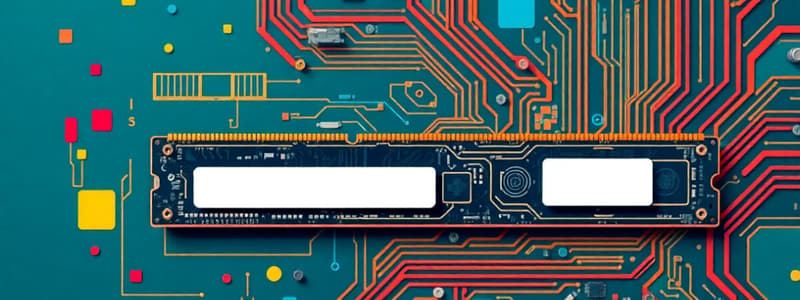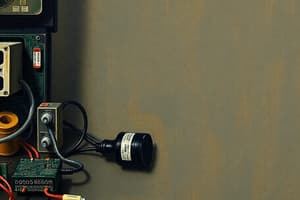Podcast
Questions and Answers
Which of the following is not a function of the Output Unit?
Which of the following is not a function of the Output Unit?
- It converts binary data into a readable format
- It displays information on a screen
- It communicates with external devices
- It supplies the data and instructions to the computer for further processing (correct)
Which is not considered to be a computer peripheral device?
Which is not considered to be a computer peripheral device?
- Monitor
- Keyboard
- Printer
- CPU (correct)
What is the smallest unit of data in a computer?
What is the smallest unit of data in a computer?
- Kilobyte
- Bit (correct)
- Nibble
- Byte
Which of the following is not a characteristic of a computer?
Which of the following is not a characteristic of a computer?
Which of the following is independent of the address bus?
Which of the following is independent of the address bus?
Which of the following is not a type of optical disk?
Which of the following is not a type of optical disk?
Another name for a logic chip is...
Another name for a logic chip is...
Computer memory in which the user cannot write new information or instruction is...
Computer memory in which the user cannot write new information or instruction is...
What is produced during the process of data processing?
What is produced during the process of data processing?
The primary storage unit is also known as...
The primary storage unit is also known as...
What term describes the physical layout of a network?
What term describes the physical layout of a network?
What is the primary function of DHCP in an internet-connected network?
What is the primary function of DHCP in an internet-connected network?
Which of the following is an example of a nonimpact printer?
Which of the following is an example of a nonimpact printer?
The term “booting” refers to which of the following processes?
The term “booting” refers to which of the following processes?
What is the term used for the outputs displayed on a screen?
What is the term used for the outputs displayed on a screen?
Which application is rarely included in an office suite?
Which application is rarely included in an office suite?
What is the best description of a register's length in computer architecture?
What is the best description of a register's length in computer architecture?
What does GUI stand for in computing?
What does GUI stand for in computing?
Which protocol governs the communication over the Internet?
Which protocol governs the communication over the Internet?
Which file format is used to store Adobe Acrobat files?
Which file format is used to store Adobe Acrobat files?
Flashcards
Binary System
Binary System
A two-state system representing data on a computer, using 0s and 1s.
Gigahertz (GHz)
Gigahertz (GHz)
The speed of a computer's processor, measured in billions of cycles per second.
Soft Copy
Soft Copy
Output displayed on a screen, such as a monitor.
What is a CPU?
What is a CPU?
Signup and view all the flashcards
Nonimpact Printer
Nonimpact Printer
Signup and view all the flashcards
What is a peripheral device?
What is a peripheral device?
Signup and view all the flashcards
Optical Mark Recognition (OMR)
Optical Mark Recognition (OMR)
Signup and view all the flashcards
L1 Cache
L1 Cache
Signup and view all the flashcards
What is a computer port?
What is a computer port?
Signup and view all the flashcards
What is ROM?
What is ROM?
Signup and view all the flashcards
Word Size
Word Size
Signup and view all the flashcards
Uniform Resource Locator (URL)
Uniform Resource Locator (URL)
Signup and view all the flashcards
What is a byte?
What is a byte?
Signup and view all the flashcards
How many bytes are in a megabyte?
How many bytes are in a megabyte?
Signup and view all the flashcards
'.com' Domain
'.com' Domain
Signup and view all the flashcards
What are device drivers?
What are device drivers?
Signup and view all the flashcards
Groupware
Groupware
Signup and view all the flashcards
What are the two basic types of memory in a computer?
What are the two basic types of memory in a computer?
Signup and view all the flashcards
What is a CD?
What is a CD?
Signup and view all the flashcards
What is outputting?
What is outputting?
Signup and view all the flashcards
Study Notes
Computer Components and Functions
- Peripherals: The CPU is not a peripheral device. Peripherals are devices external to the CPU.
- Data Transfer: Ports facilitate data exchange between devices and the computer system.
- Read-Only Memory (ROM): ROM is non-writable memory, holding critical startup instructions.
- Byte: A byte is a group of 8 bits.
- Megabyte Conversion: A megabyte equals 1,000,000 bytes.
- Device Drivers: Device drivers enable input/output devices to communicate with the computer.
- Memory Types: Primary and secondary memory are the two fundamental memory categories.
- CD-ROM: A CD-ROM is a non-erasable optical disk storing audio or data.
- Outputting Data: The process of providing useful data to a user is called outputting.
- Plotting Devices: Plotters are devices creating images and drawings.
- Different Printer Types: Drum printers print one line at a time.
- CRT Monitors: Cathode Ray Tube (CRT) monitors, now largely outdated, are common/typical with larger computer systems.
- Output Unit Functions: The output unit displays processed data.
- Data Bit: The smallest unit of data in a computer system is a bit.
- Input Unit Functions: The input unit provides data/instructions to the computer system for processing.
- Data & Information: Data is raw material; processed data is information.
- Computer Characteristics: I.Q. is not a computer characteristic.
- Main Memory Size: The size of main memory generally depends on the address bus.
- MAR Definition: MAR stands for Memory Address Register.
- Optical Disk Technology: Laser beams read/write data on optical disks.
- Memory Independence: Secondary memory functions independently of the address bus, unlike main memory.
- Optical Disk Types: Winchester drives are not optical disks.
- Input Devices: Bar code readers are input devices.
- Primary Storage Synonym: Memory is also known as primary storage.
- End-users: Non-technical computer users are often referred to as end-users.
- Powerful Computers: Supercomputers are the most powerful types.
- Primary Storage Alias: The primary storage unit is also known as memory.
- Memory Type Exclusion: QRAM is not a recognized memory type.
- Logic Chip Alias: A logic chip is often called a microprocessor.
- Binary Representation: Computers use the binary system (0s and 1s) to represent data.
- Processor Speed Metric: Processor speeds are measured in gigahertz (GHz).
- Soft Copy Output: Screen output is classified as a soft copy.
- Printer Type: Ink-jet printers are non-impact printers.
- Optical Mark Recognition: OMR stands for Optical Mark Recognition.
- Office Suite Applications: Antivirus programs are not typically part of an office suite.
- File Format: Adobe Acrobat files are stored in PDF format.
- Startup Process: Booting is the process of loading the operating system.
- Operating System Types: MS Access is not an operating system.
- Cache Memory Location: L1 cache memory is built within the CPU chip itself.
- Register Size: The size of a register is called word size.
- Website Address: A website address is a uniform resource locator (URL).
- Most Common Top-Level Domain: .com is the most commonly used top-level domain.
- Collaborative Software: Groupware is another name for collaborative software.
- Screen Navigation: Scrolling moves pages up or down on the screen.
- Main Circuit Board: The motherboard is the main circuit board in a personal computer.
- Dynamic Host Configuration Protocol: DHCP is a protocol assigning IP addresses.
- Internet Communication Protocol: TCP/IP governs Internet communication.
- Personal Finance Application: Spreadsheet is the most suitable for personal finance records.
- Signal Conversion: Computer signals sent over phone lines must be converted to analog signals..
- Network Physical Structure: Network topology describes the physical layout of a network.
True/False Questions
- CPU: The processor is the central processing unit (CPU). (True)
- Secondary Storage Immediate Use: Secondary storage does not contain instructions/data used immediately by the processor. (False)
- Homepage: A website's home page is the main page. (True)
- Supercomputers: The most powerful personal computers are not supercomputers. (False)
- Modem Functionality: A modem connects computers to telephones. (True)
- Secondary Storage vs Memory: Secondary storage is not memory. (False)
- Processed Data: Processed data is known as information. (True)
- TCP/IP as Hardware: TCP/IP is not hardware but a protocol. (False)
- Magnetic Tape Use Case: Magnetic tape is often used for data backups. (True)
- LAN Geographic Scope: A LAN (Local Area Network) is not between two different cities. (False)
Fill-in-the-Blank
- Computer Components: Input, Output, Storage, and CPU are the four general components. (CPU)
- GUI Definition: GUI stands for Graphical User Interface.
- Binary Unit: A 0 or 1 in the binary system is a bit.
- Main Circuit Board Name: Motherboard is the main circuit board inside the system unit.
- SOHO Acronym: SOHO stands for Small Office/Home Office.
- Operating System Kernel: The kernel is a resident operating system program.
- File Compression Tool: A file compression utility reduces file size.
- Booting Explanation: Loading the operating system into memory is known as booting.
Studying That Suits You
Use AI to generate personalized quizzes and flashcards to suit your learning preferences.




